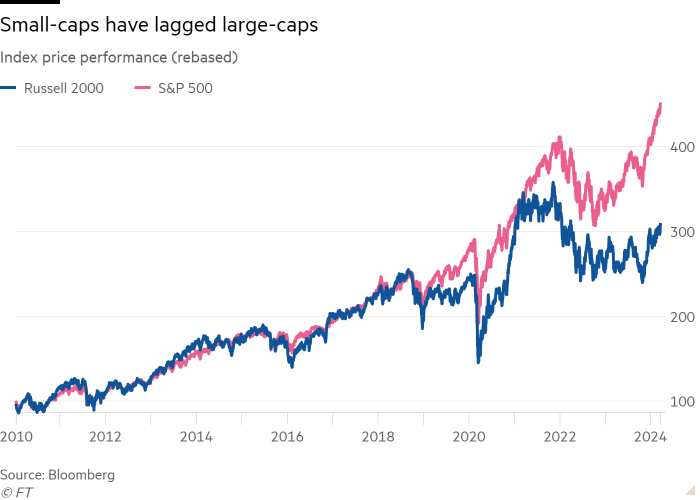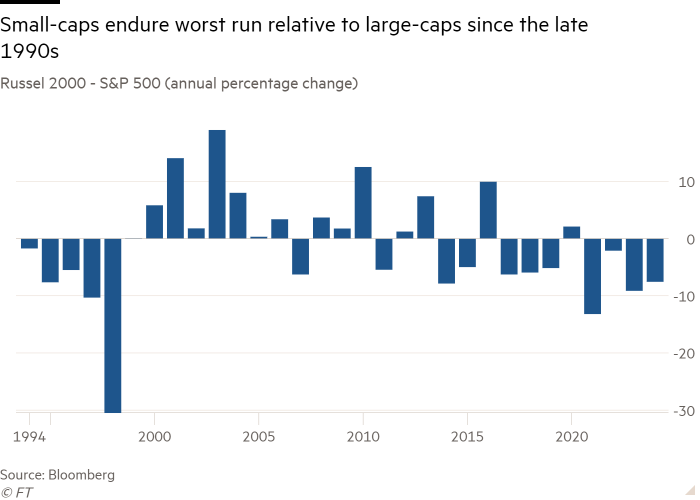Stay informed with free updates
Simply sign up to the US equities myFT Digest — delivered directly to your inbox.
US small-cap stocks are suffering their worst run of performance relative to large companies in more than 20 years, highlighting the extent to which investors have chased megacap technology stocks while smaller groups are weighed down by high interest rates.
The Russell 2000 index has risen 24 per cent since the beginning of 2020, lagging the S&P 500’s more than 60 per cent gain over the same period. The gap in performance upends a long-term historical norm in which fast-growing small-caps have tended to deliver punchier returns for investors who can stomach the higher volatility.
The unusually wide spread between the two closely watched indices has opened up in recent years as small-cap stocks with relatively weak balance sheets and modest pricing power have been especially hurt by high inflation and a steep rise in borrowing costs, according to analysts, putting off many investors.
“I’ve been investing in small-caps for almost 30 years and you haven’t seen big money moving into the space since 2016 or 2017,” said Greg Tuorto, a small-cap portfolio manager at Goldman Sachs Asset Management.
“You need a little greed, you need some of those animal spirits, maybe a pick-up in M&A [mergers and acquisitions] or a booming IPO market, for small-caps to really take off,” he added.
The S&P has climbed steadily since early November, with strong earnings and investor excitement about the artificial intelligence boom driving huge gains for the likes of Nvidia and Meta.
In contrast, the small-cap rally that gathered pace in the final months of 2023 has petered out this year, expanding an already wide gap in performance. Utilities and telecoms groups such as broadband company Gogo, Vertex Energy and Middlesex Water are among stocks that have been hit.
Aside from a brief period of outperformance in 2020 during the early stages of the coronavirus pandemic, small-cap stocks have lagged their larger peers since 2016.
In the 2000s, before global interest rates sank to close to zero following the financial crisis, thinly-traded and under-analysed stocks had on average outperformed the biggest companies. Analysts attribute this pattern to a combination of market inefficiency and the explosive growth potential of tomorrow’s market leaders.
“When you get small-caps right, you’re not right by 20 per cent more than the Street, your earnings and revenue estimates could be double where the consensus is . . . That leads to a more significant price gain,” said Tuorto, whose portfolio is dominated by stocks including Shake Shack and Wingstop, as well as retailers.
Although there are signs that the equity market rally is beginning to broaden out beyond the biggest tech stocks, stubborn inflation and a resilient jobs market have recently contributed to an acceptance among traders that interest rates may stay higher for longer than they had anticipated just a few months ago.
In a worst-case scenario where the Federal Reserve is forced to keep rates on hold for months to come or even raise them, smaller companies are likely to be the hardest hit. Roughly 40 per cent of debt on Russell 2000 balance sheets is short-term or floating rate, compared with about 9 per cent for S&P companies.
Fourth-quarter earnings for Russell 2000 companies, about 30 per cent of which are unprofitable, fell 17.6 per cent year-on-year, according to LSEG data. Earnings for S&P companies, in contrast, rose by about 4 per cent, although a large portion of the gain was driven by the so-called Magnificent Seven tech stocks.

However, barring a recession, small-cap profits are expected to improve as rates start to come down. Fed chair Jay Powell last week left rates unchanged and signalled a preference to cut by three-quarters of a percentage point this year, pushing the Russell 2000 up by a percentage point more than the S&P on the day.
“If [small-cap] earnings pick up, people will buy the stocks,” said David Lefkowitz, head of US equities in UBS’s chief investment office. “And earnings should pick up.” Analysts on average expect 14 per cent earnings growth for Russell 2000 companies this year.
“Access to capital is improving, financial conditions have eased, the high-yield markets are wide open and equity issuance is really picking up,” Lefkowitz added.
For Jill Carey Hall, US equity strategist and head of US small and mid-cap strategy at Bank of America, the lower valuations of small-caps bodes well for returns. The sector has historically traded at similar multiples to the S&P 500, but thanks to the surge in large-caps in recent months is now trading at a near-record discount.
“The only other time you’ve seen relative multiples this cheap was during 1999 and 2000, and that ended up being a great decade for small-caps,” she said.


